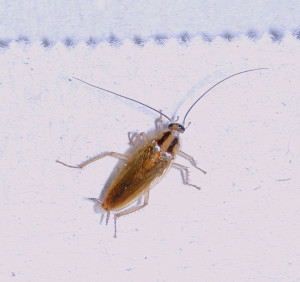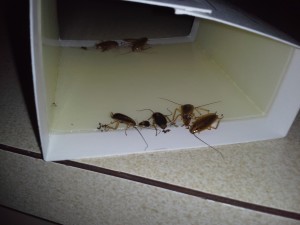 German cockroaches are our most prolific cockroach species producing 3-6 generations per year. Besides its importance as a sign of poor sanitation used by health departments, the German cockroach has been implicated in the transmission of several pathogenic organisms and as a cause of allergic reactions for children and adults. Prompt attention to sanitation and control are necessary to prevent this pest from becoming abundant.
German cockroaches are our most prolific cockroach species producing 3-6 generations per year. Besides its importance as a sign of poor sanitation used by health departments, the German cockroach has been implicated in the transmission of several pathogenic organisms and as a cause of allergic reactions for children and adults. Prompt attention to sanitation and control are necessary to prevent this pest from becoming abundant.
Identification
Adults are 1/2 to 5/8 inches long, light brown to tan, with two dark stripes on the shield (pronotum) behind the head. Females are often seen carrying a yellowish-brown egg capsule (ootheca) protruding from the end of the abdomen. Nymphs are generally darker with two prominent dark stripes surrounding a lighter tan spot or stripe on body midsection (thorax).
General Information
German cockroaches are our most prolific cockroach species producing 3-6 generations per year. Besides its importance as a sign of poor sanitation used by health departments, the German cockroach has been implicated in the transmission of several pathogenic organisms and as a cause of allergic reactions for children and adults. Prompt attention to sanitation and control are necessary to prevent this pest from becoming abundant at school facilities. German cockroaches do not enter structures from outdoors, they are spread entirely by humans and live only indoors. German cockroaches spend most of their lives in cracks and protected void areas near sources of food and water.
Suggested Thresholds
One cockroach justifies baiting and monitoring efforts. More than 5 cockroaches per inspection should trigger a complete review of sanitation and control efforts and possibly a more aggressive treatment strategy.
Monitoring and Inspection
The number one monitoring tool for cockroaches is an adhesive-coated, cardboard insect monitoring trap, also known as “sticky traps”. Some sticky traps have a German cockroach aggregation pheromone and are effective in attracting roaches to the monitor. The pheromone traps are effective with low populations and detecting new infestations. These inexpensive devices should be placed in pest vulnerable areas including food storerooms and preparation areas, and anywhere else cockroaches have been a problem including laundry rooms, custodial closets, electrical closets, storage closets, staff lounges and student stores. Insect monitors are exceptional in detecting cockroaches but also in indicating direction of travel, species present, and whether immatures as well as adults are present.
Inspection practices should include checking for unsealed openings such as missing or loose pipe and conduit escutcheon plates, unsealed edges around sinks and cabinets, unsealed edges of bulletin boards or wall-mounted electrical panels, mirrors, light fixtures, fire alarms or emergency lighting. Inspections should focus on areas where food and water are present including food storage, kitchens, food-serving lines, cafeterias, locker rooms, and staff lounges.
Cockroach Monitoring Station
- Monitoring stations or units should always be dated to monitor activity over time.

- Be sure to place enough monitoring units to accurately monitor an area because monitors provide valuable information about pest activity. Food service areas should have more monitors than nonfood areas.
- If a trap is consistently empty, the trap may be relocated to another site.
- Create a map of the area that includes the location of the traps. You may also leave space on your map to write numbers of insect per trap for each inspection. It may be helpful to use monitor locators such as stickers.
- Monitors should be placed along walls or in corners.
- Monitors should be kept out of view if possible. Monitors may be secured with double sided tape.
- They should be placed in clean, dry areas close to suspected cockroach harborage.
- If possible, monitors should be placed in between resources (harborage, food, and water) where cockroaches may travel.
- Monitors should be replaced if full or if the monitor has been wet or is covered in dust.
- Monitor placement is critical and they should be placed along structural lines, adjacent to walls, corners etc., where roaches travel.
Nonchemical Control Measures
Cultural and mechanical management options are preferred. This includes prompt clean up of spills, proper food storage and waste handling, preventing access to water by fixing plumbing leaks, eliminating harborage and access to the building by sealing cracks and crevices, removing products from cardboard shipping containers before shelving, and inspecting incoming product and rejecting any containing cockroaches, cockroach droppings or egg cases.
Sanitation/Cultural Control Measures
- Remove individual cockroaches using a vacuum or wipe.
- Use a flushing agent, such as compressed air, or a heat gun directed into cracks and crevices harboring cockroaches and vacuum up cockroaches as they emerge.
- Eliminate the harborage by sealing cracks, sealing edges around wall-mounted electrical panels, light fixtures, bulletin boards, posters, sinks, cabinets, etc.
- Clean up food and drink spills immediately.
- Inspect incoming products for cockroaches, droppings, or egg cases and reject infested products.
- Follow up with suppliers who deliver infested products and change suppliers if the problem is not resolved.
- Store food items in sealed containers.
- Place exterior trash cans and dumpsters away from building entrances.
- Clean drains, cracks and crevices with an enzyme-based cleaner.
Physical/Mechanical Control Measures
- Caulk and seal potential harborages around water and food prep sites.
- Clean on a schedule, including less accessible areas.
- Use a HEPA vacuum to remove heavy infestations prior to treatment
- Remove food products and food service supplies from cardboard containers as soon as they are delivered and put cardboard in outdoor recycling containers to avoid introducing cockroaches and egg cases.
- Use liners for waste containers and empty at the end of the day so that food and food waste is not left in the building overnight.
- Fix plumbing leaks, gutters that hold water and damp wood to eliminate access to water.
- Position exterior lighting to avoid attracting cockroaches to building entryways at night.
- Use sodium vapor or yellow bulbs for exterior lighting to reduce attraction to cockroaches.
- Store teachers classroom and art supplies in sealed containers – avoid cardboard for storage of food items like beans and macaroni used as art supplies or snacks. Cockroaches thrive in cardboard.
Chemical Control Measures
Chemical management options that reduce potential for exposure include insecticide baits in:
- Pre-manufactured, enclosed bait stations
- Gel, liquid, or dry flowable baits placed in cracks and crevices
Insect growth regulator (IGR) applied to harborage areas or in a “point source” delivery system will prevent the proper development of immature cockroaches so they cannot reproduce as adults. Insect growth regulators used in conjunction with baits are highly effective because gravid (pregnant) female cockroaches eat more when exposed to IGRs, so more bait will be consumed.
Boric acid dusts applied to dry, inaccessible void areas may also provide some control. Care should be taken when applying any kind of dust so that it does not become airborne.
Where cockroach infestation levels are extremely high, aggressive treatment may include all previously mentioned actions plus the targeted application of a liquid residual to known harborage areas. It is important to note that using a repellent liquid in an area where bait may be applied will render the bait ineffective because the repellent treatment will contaminate the bait and cockroaches will not consume it. Some baits work as quickly as liquids do, particularly with some cockroach populations that have developed insecticide resistance to many liquid spray products, so it is critical to evaluate the effectiveness of the treatment after it is complete.
Chemical options, including baits, should NOT be used on a routine or calendar-based schedule but only where cockroach presence has been confirmed and non-chemical measures are also implemented.
Always read and follow the label. The label is the law. Pesticides must be used in accordance with federal, state and local regulations. Applicators must have proper credentialing to apply pesticides and should always wear personal protective equipment (PPE) as required by the pesticide label during applications. All labels and Material Safety Data Sheets (MSDS) for the pesticide products authorized for use in the IPM program should be maintained.
Evaluation Methods
Once sticky trap monitoring has been introduced into the IPM program, traps should be monitored on a monthly basis and re-evaluate use after six months or more.
Additionally for German cockroach infestations, baits and gel applications should be monitored after the first two weeks to see if bait as been taken by the roaches. Then every two weeks until trap numbers are reduced to zero with no nymphs or egg cases are being reported, then bait can be withdrawn from area and monitoring can resume.
Authors: Compiled from publications by Mike Merchant, Janet Hurley, Faith Oi
